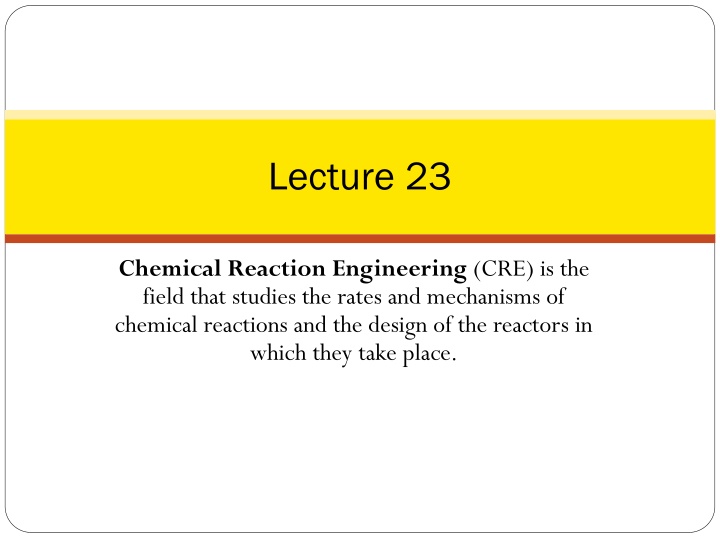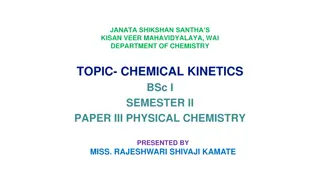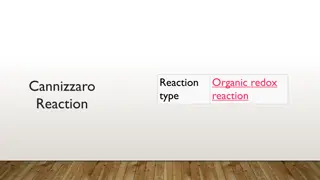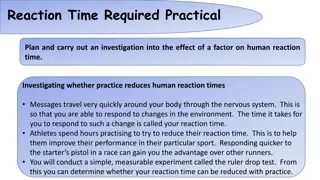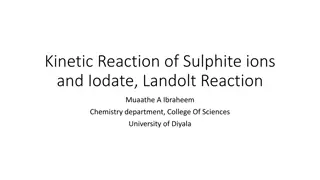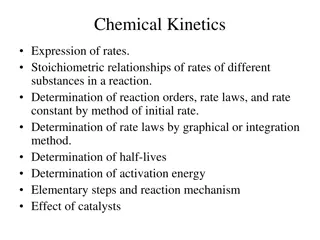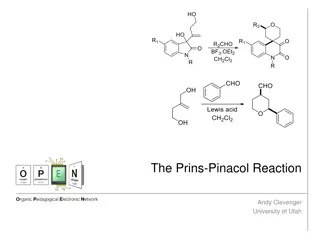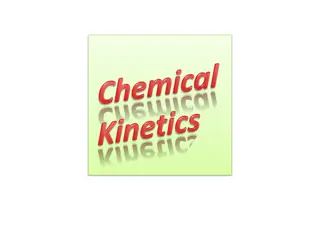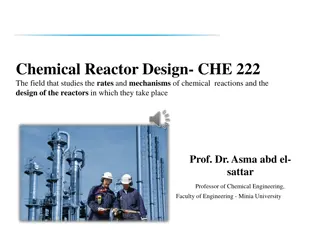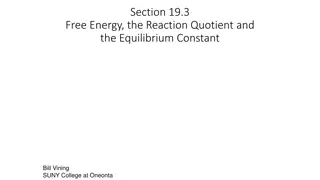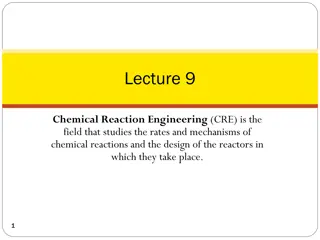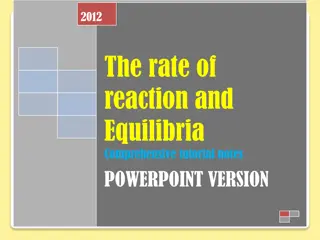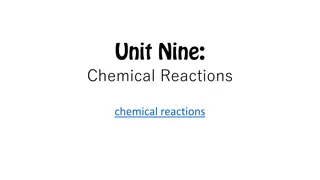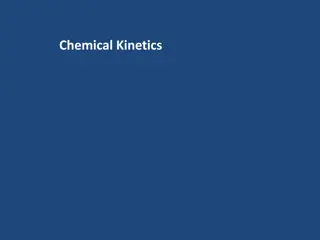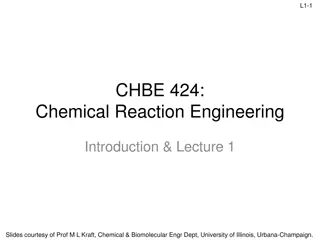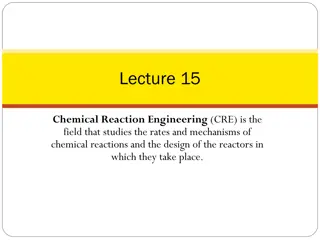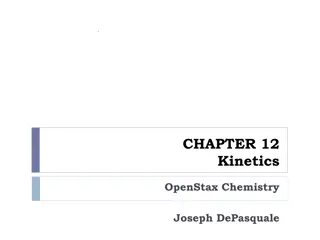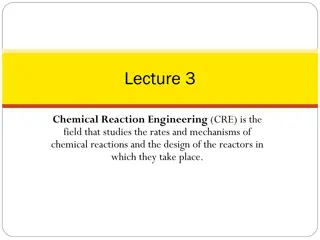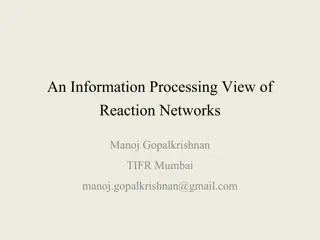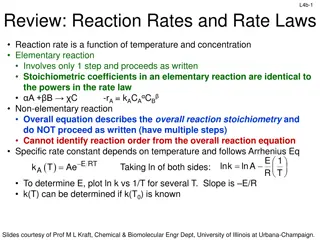Introduction to Chemical Reaction Engineering
Chemical Reaction Engineering (CRE) is a field that delves into the rates and mechanisms of chemical reactions, as well as the design of reactors for these processes. Explore topics such as steady states, heat effects in CSTR, energy balance equations, and more in the realm of CRE.
Download Presentation

Please find below an Image/Link to download the presentation.
The content on the website is provided AS IS for your information and personal use only. It may not be sold, licensed, or shared on other websites without obtaining consent from the author.If you encounter any issues during the download, it is possible that the publisher has removed the file from their server.
You are allowed to download the files provided on this website for personal or commercial use, subject to the condition that they are used lawfully. All files are the property of their respective owners.
The content on the website is provided AS IS for your information and personal use only. It may not be sold, licensed, or shared on other websites without obtaining consent from the author.
E N D
Presentation Transcript
Lecture 23 Chemical Reaction Engineering (CRE) is the field that studies the rates and mechanisms of chemical reactions and the design of the reactors in which they take place.
Web Lecture 23 Class Lecture 19 - Tuesday CSTR With Heat Effects Multiple Steady States Ignition and Extinction Temperatures 2 2
CSTR with Heat Effects Courtesy of Pfaudler, Inc. 3
Unsteady State Energy Balance E d n n = = Q W sys + = F H F H S 0 i 0 i i i dt i 1 i 1 Neglect ( ) E = = = N E N H PV N H PV Using sys i i i i i i i dE d N H dH dN sys i i = = = N H i i i i dt dt dt dt dH dT i= C Pi dt dt dN = + i r V F F i A 0 i i dt 4
Unsteady State Energy Balance We obtain after some manipulation: ( ( ) ( ) T ) Q W + F C T T H r V dT S 0 i Pi 0 i Rx A = dt N C i Pi ( ) Q = F a WS= Collecting terms with coolant flow rates, and and high UA = T T 0 F 0 i A 0 i 5 5
Unsteady State Energy Balance C P 0 C ( )( ) ( ) ( ( ) ) + H r V F T T UA T T Rx A A 0 i P 0 a i dT = dt N C i P i R T G T V r F UA ( ) = + A 0 C H C T T T T A F R P 0 a N F C 0 i P A 0 A 0 P i S 6
Unsteady State Energy Balance F dT ( ) T ( ) T = A 0 C G R dt N i P i ) ( ) ( P C 0 = G T r V H A Rx ( ) T ( ) ( ) = + + R 1 T T T 0 a + T T ( ) ( )( ) = + = + 0 1 a R ( T ) C 1 T C 1 T T P P C + 0 0 UA + T T = = 0 a T AC F C + 1 0 P 0 7 7
Unsteady State Energy Balance dT dt =G T ( ) R T ( ) If G(T) > R(T) Temperature Increases If R(T) > G(T) Temperature Decreases 8
Steady State Energy Balance for CSTRs At Steady State dT dN = = 0 A dt dt = r V F X A A 0 ( ) T ( ) ( T = G R T 0 ( ) ) ( ) = H F X F C T UA T T 0 Rx A 0 A 0 i P 0 a i Solving for X. 9 9
Steady State Energy Balance for CSTRs Solving for X: UA ( ) ( ) + C T T T T i P 0 a F i = = A 0 X X EB H Rx Solving for T: ( ) + + F X H UAT F C T A 0 Rx UA a A 0 i P 0 = T i + F C A 0 i P i 10
Steady State Energy Balance for CSTRs UA ( ) ( ) = + X H C T T T T Rx P 0 a F C 0 A 0 P 0 UA Let = AC F 0 0 P + T T ( ) ( ) ( ) = + = + 0 1 a X H C T T T T C 1 T Rx P 0 a P + 0 0 ( )( ) = + C 1 T T P C 0 + T T = 0 a T C + 1 11
Steady State Energy Balance for CSTRs G ( T ) R ( T ) X H C 1 + T T C ( )( ) = Rx P 0 ( )( ) + C 1 T T = P 0 C X H Rx H ( CP01+ ( )X ( ) ) Rx T =TC+ 12 12
Steady State Energy Balance for CSTRs R(T) Increasing T0 T Variation of heat removal line with inlet temperature. 13
Steady State Energy Balance for CSTRs = =0 R(T) Increasing Ta T0 T Variation of heat removal line with ( =UA/CP0FA0) 14
F X = A 0 V ( ) r X , T A A B F X 1) Mole Balances: = A 0 r V A r = kC 2) Rate Laws: A A 15
( ) = 3) Stoichiometry: C C 1 X A A 0 F X C X 4) Combine: = = A 0 A 0 0 V ( ) ( ) kC 1 X kC 1 X A 0 A 0 X = k 1 X E RT k Ae + = = X + E RT 1 k 1 Ae E RT Ae + ( ) T ( ) ( ) = = G X H H Rx Rx E RT 1 Ae 16 16
Multiple Steady States (MSS) Variation of heat generation curve with space-time. 17 17
Multiple Steady States (MSS) Finding Multiple Steady States with T0 varied 18 18
Multiple Steady States (MSS) Finding Multiple Steady States with T0 varied 19 19
Multiple Steady States (MSS) Temperature ignition-extinction curve 20 20
Multiple Steady States (MSS) Stability of multiple state temperatures 21 21
MSS - Generating G(T) and R(T) dT = 1 dt ( ) C ( ) = G = T X 1 H Rx ( ) ( ) + R T T P C 0 Need to solve for X after combining mole balance, rate law, and stoichiometry. 22 22
MSS - Generating G(T) and R(T) For a first order irreversible reaction tau k = X ( ) + 1 tau k E 1 1 = k k exp 1 R T T 1 Parameters ( ) Tau , H k , , E , R T , T , kappa, , C Rx 1 1 C 0 P Then plot G and R as a function of T. 23 23
End of Web Lecture 23 Class Lecture 19 24 24
